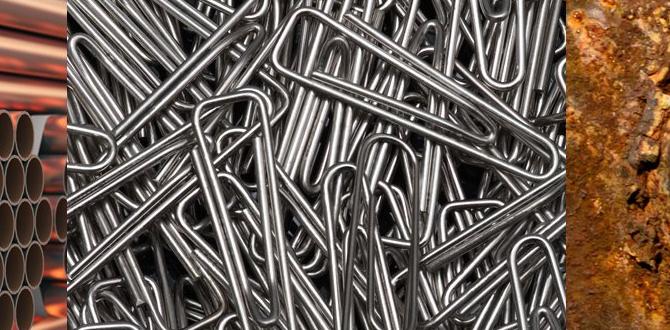Quick Summary:
For precise cuts and smooth finishes, a 3/16 inch carbide end mill with an 8mm shank is crucial. Prioritizing low runout ensures your tool spins perfectly true, minimizing wobble and improving accuracy for detailed milling projects. This guide breaks down why it matters and how to select the best one.
Hey there, fellow makers! Daniel Bates here from Lathe Hub. Ever found yourself frustrated by wiggly cuts or finishes that just aren’t as crisp as you’d hoped? It’s a common puzzle for anyone diving into milling, whether it’s for metal or sturdy plastics like HDPE. Often, the culprit isn’t your machine or your skill, but the humble end mill itself – specifically, how true it runs. Today, we’re tackling the 3/16 inch carbide end mill with an 8mm shank, focusing on a vital quality: low runout. We’ll uncover why this might be the missing piece in your workshop puzzle.
Why Low Runout is a Big Deal for Your 3/16″ 8mm Shank Carbide End Mill
When we talk about “runout,” we’re essentially talking about how much a rotating tool deviates from its true center. Imagine a perfectly straight spinning rod versus one that wobbles slightly off-center. That wobble is runout. In the world of machining, even a tiny amount of runout can cause big problems, especially with small cutters like a 3/16 inch end mill.
Think about it: a 3/16 inch end mill is already quite small. It’s perfect for detailed work, engraving, or cutting intricate shapes. If this small tool is wobbling, the actual cutting edge isn’t following the path you intended. This leads to a few common headaches:
- Poor Surface Finish: The surface of your workpiece won’t be smooth. Instead, you’ll see faint ridges or chatter marks left by the unstable cutting edge.
- Inaccurate Dimensions: The actual cut will be larger or smaller than intended because the tool diameter effectively changes as it wobbles.
- Increased Tool Wear: The cutting edge isn’t making consistent contact. One part of the edge might be taking too much load, leading to premature dulling or chipping.
- Vibration and Noise: A wobbly tool vibrates more, making your machine louder and less pleasant to work with, and potentially introducing stress to your machine components.
- Difficulty in Achieving Fine Details: For tasks requiring precision, like engraving text or cutting small features, runout can make the job impossible.
A carbide end mill, because it’s made of a hard, brittle material, is particularly sensitive to inconsistent forces caused by runout. While carbide offers superior hardness and heat resistance compared to high-speed steel (HSS), it can chip more easily if subjected to shock or vibration that runout creates.
Understanding the 3/16 Inch Carbide End Mill with an 8mm Shank
Let’s break down what these specifications mean:
- 3/16 Inch: This refers to the diameter of the cutting head of the end mill. It tells you how wide a slot or groove the tool can create, or the diameter of features it can mill around. A 3/16″ diameter is a popular size for general-purpose milling, detailed work, and cutting specific shapes.
- Carbide: This material (specifically tungsten carbide) is known for its extreme hardness and ability to maintain a sharp edge at high temperatures. This makes carbide end mills ideal for cutting harder metals and plastics, and allow for faster cutting speeds than HSS tools.
- 8mm Shank: The shank is the part of the end mill that grips into your machine’s collet or tool holder. An 8mm shank is a standard metric size. For many hobbyist and smaller professional milling machines, the collet system can accommodate specific shank diameters. Having an 8mm shank means it will fit securely in an 8mm collet.
Now, why pair a 3/16 inch cutter with an 8mm shank? The 8mm shank (approximately 5/16 inch) provides a robust grip for the cutter. Even though the cutting diameter is smaller, having a slightly larger shank diameter helps in rigidity and allows for secure clamping in commonly available collets on many milling machines. This combination is excellent for achieving precise cuts on materials like aluminum, plastics (especially HDPE – High-Density Polyethylene, which is fantastic for jigs and fixtures), and even some softer steels, provided your machine has the power and rigidity.
The “Long Reach” Factor: When You Need Extra Depth
Sometimes, you’ll see “long reach” specified. For a 3/16 inch end mill, this means the distance from the shank to the cutting flutes is extended. This is incredibly useful when you need to mill deeper pockets or reach features that are recessed into a workpiece.
However, a longer reach also presents a greater potential for runout and vibration. The further the cutting edge is from the rigid support of the collet, the more leverage it has to flex or wobble. This is where the quality of the end mill, particularly its manufacturing precision and straightness, becomes paramount. A high-quality, low-runout long-reach end mill is essential for success in these applications.
If you’re working with HDPE, for instance, and need to create deep channels or pockets, a precise 3/16 inch long-reach end mill with minimal runout will make a world of difference in the quality of your finished part. You can learn more about the properties of HDPE and its machining applications at resources like the MatWeb material property database, which often details how materials react to machining processes.
What Exactly is “Low Runout” in Machining?
In professional machining, tolerances for runout are very tight. For a high-quality tool, you’re looking for runout that is measured in mere “tenths” (ten-thousandths of an inch) or microns. For a hobbyist or beginner, achieving runout this low might seem like a lofty goal, but the principle remains the same: the less wobble, the better the cut.
Consider that many decent milling machine spindles themselves have a runout specification. A good machine might have spindle runout of less than 0.0002 inches. If your end mill has significant runout on top of that, the total runout at the cutting tip can be substantial. We aim for end mills that are manufactured to be as straight as possible – ideally, their runout is significantly less than the spindle’s runout, or at least so low that it’s not the dominant factor in cut inaccuracy.
How to Identify and Achieve Low Runout
Identifying low runout in an end mill before you buy can be tricky without specialized equipment. However, here are some indicators and practices:
- Reputable Brands: High-quality manufacturers invest in precise grinding processes and quality control. They are more likely to produce end mills with very low runout. Brands known for precision tooling are a good starting point.
- Manufacturing Location & Standards: Tools made in countries with stringent manufacturing standards and designed for professional use often exhibit better quality.
- Price as an Indicator: While not always true, extremely cheap end mills often cut corners on manufacturing precision, which can include tighter runout tolerances.
- Visual Inspection: Look for symmetry. The flutes should appear uniform, and the cutting edges should look sharp and evenly ground. A visible imperfection might hint at manufacturing issues.
- Collet Quality is Key: Even the best end mill can suffer from runout if it’s not held properly. High-quality collets are essential. A worn or damaged collet, or one that isn’t seated correctly, will introduce runout. ER collets are very popular in small milling machines due to their accuracy and versatility.
- Proper Tool Holder Use: Always clean the collet, the collet nut, and the shank of the end mill before inserting. Any small piece of debris can cause the tool to run off-center.
- Measure It Yourself (If Possible): If you have a dial indicator, you can measure the runout of an end mill mounted in your machine. Mount the end mill, bring a dial indicator tip to the cutting edge or shank, zero it, and rotate the spindle by hand to see the maximum deviation.
Choosing the Right 3/16 Inch 8mm Shank Carbide End Mill
When selecting your 3/16 inch 8mm shank carbide end mill, especially one designed for low runout, consider these factors:
Types of End Mills and Their Flute Count
The number of flutes (the helical cutting edges) on an end mill affects its performance:
| Flute Count | Best For | Considerations |
|---|---|---|
| 2 Flutes | Plastics (like HDPE), Aluminum, softer materials, slots, plunge cuts. | Good chip evacuation, less prone to clogging. Can chatter in harder materials. |
| 3 Flutes | General purpose, steels, cast iron, some plastics. Good balance. | Better than 2-flute for harder materials, good chip load. |
| 4 Flutes | Harder steels, cast iron, difficult-to-machine materials. | Best for heat dissipation and rigidity. Can struggle with chip evacuation in softer materials, potentially clogging. |
For cutting HDPE, a 2-flute end mill is often recommended because HDPE tends to melt rather than chip. The lower flute count provides better chip evacuation and reduces heat buildup. However, if you need to cut a range of materials, a 3-flute carbide end mill can be a very versatile choice.
Coating Options
Some carbide end mills come with coatings that enhance their performance. For general use and for materials like HDPE and aluminum, uncoated carbide is often perfectly adequate. However, if you plan to machine harder metals or at higher speeds, coatings can be beneficial:
- TiN (Titanium Nitride): A common, general-purpose coating that adds hardness and reduces friction. Good for a wide range of materials.
- TiCN (Titanium Carbonitride): Harder than TiN, offering better abrasion resistance and performance in harder steels.
- AlTiN (Aluminum Titanium Nitride): Excellent for high-temperature applications, particularly in machining steels and stainless steels. It forms an oxide layer that protects the coating at high heat.
For HDPE, simplicity is key. Uncoated carbide is usually the way to go. If you’re getting a bit more advanced and looking at steels with your 3/16″ end mill, TiN or AlTiN could be worth considering, but remember the 8mm shank might limit the depth of cut you can achieve in tougher materials with a tool this size on a less powerful machine.
“Square” vs. “Ball” vs. “Corner Radius” End Mills
The shape of the tip matters for the kind of cuts you can make:
- Square End Mill: Has a flat tip. Ideal for cutting slots, pockets, and square shoulders. This is your go-to for general-purpose milling.
- Ball End Mill: Has a hemispherical tip. Used for creating contoured surfaces, 3D milling, and rounding internal corners.
- Corner Radius End Mill: Has a small radius on the tip corners. This helps to strengthen the corners, reducing chipping, and creates a radiused internal corner in a pocket. Useful for tougher materials or when you want to avoid sharp internal corners that can be stress risers.
For most beginner tasks with a 3/16″ end mill, a square end mill will be the most versatile. If you’re doing 3D carving or need smooth, rounded internal corners in a part, a ball end mill or a corner radius end mill (e.g., a 0.030″ or 0.060″ radius on a 3/16″ diameter tool) would be specified.
Practical Applications for a 3/16″ 8mm Shank Low Runout End Mill
This specific tool combination opens up a lot of possibilities in the home workshop or for apprentices:
- Jigs and Fixtures: Machine precise slots, holes, and locating features for woodworking or metalworking jigs. HDPE is fantastic for this, and a 3/16″ end mill is a common size for many jig designs.
- Engraving and Text: With very low runout, you can engrave names, labels, or decorative patterns onto workpieces of metal or plastic.
- Small Part Machining: Creating intricate components for models, robots, or custom mechanical assemblies.
- Trimming and Profiling: Following a template to cut out precise shapes from sheet material.
- Deburring Edges: While not its primary purpose, a light pass can clean up burrs.
The 8mm shank ensures a good grip for the tool in many common collet chucks found on smaller milling machines like the Grizzly G8689 Milling Machine or similar compact machines.
Ensuring Proper Use and Tool Holding for Minimal Runout
Owning a precision tool is only half the battle; using it correctly is essential to realize its low-runout benefits.
Collet Selection and Insertion
The collet is the direct interface between your machine’s spindle and the end mill shank. For an 8mm shank, you’ll need an 8mm collet. High-quality collet systems, such as ER-series collets, are designed for accuracy.
- Cleanliness is Crucial: Before inserting the end mill, ensure the shank and the inside of the collet are scrupulously clean. Any dirt, oil, or swarf can prevent the shank from seating properly, introducing runout.
- Proper Seating: Insert the end mill shank into the collet bore. You should feel it seat firmly.
- Nut Tightening: When tightening the collet nut, ensure it’s snug. Over-tightening can damage the collet, while under-tightening won’t hold the tool securely. Follow your machine or collet manufacturer’s recommendations. For ER collets, the nut tightens onto the collet, which then compresses around the shank.
Depth of Cut and Feed Rate
Even with a low-runout tool, pushing your machine too hard can cause problems.
- Start Conservatively: For any new material or setup, begin with a shallow depth of cut and a moderate feed rate. You can always increase these parameters once you see how the tool and machine are performing.
- Listen to Your Machine: Unusual noises, excessive vibration, or a poor finish are signs that you need to back off on the cutting parameters.
- Peck Drilling for Chip Evacuation: If you’re plunging into material to create a deep pocket, consider “peck drilling.” This involves drilling a short distance, retracting the tool to clear chips, and then continuing. This prevents chips from accumulating and jamming the flutes, which can cause tool breakage or poor finish.
Coolant and Lubrication
While many plastics can be machined dry, for metals and even some tougher plastics, a coolant or lubricant can significantly improve tool life and surface finish. For aluminum and plastics, a simple spray coolant or even isopropyl alcohol can help, reducing friction and carrying away heat and chips. For steels, a dedicated cutting fluid is recommended.
Troubleshooting Common Issues
Even with the best tools, issues can arise. Here’s how to tackle common problems when using your 3/16 inch 8mm shank carbide end mill:
- Wobbly Cut Regardless of Tool: If you’re experiencing wobble with multiple end mills, the problem is likely with your machine’s spindle or your collet system. Check spindle runout with a dial indicator and inspect your collets for damage or wear.
- Poor Surface Finish:
- Too high of a feed rate: The tool is taking too big a bite, leading to chatter.
- Too low of a spindle speed (RPM): Not enough cutting force or heat generation.
- Dull tool: The cutting edge is no longer sharp.
- Material buildup in flutes: Especially common in plastics. Use a brush to clear or consider chip breakers if applicable.
- Tool Breaking:
- Cutting too deep or too fast: Exceeding the tool’s or machine’s capabilities.
- Chips not clearing





